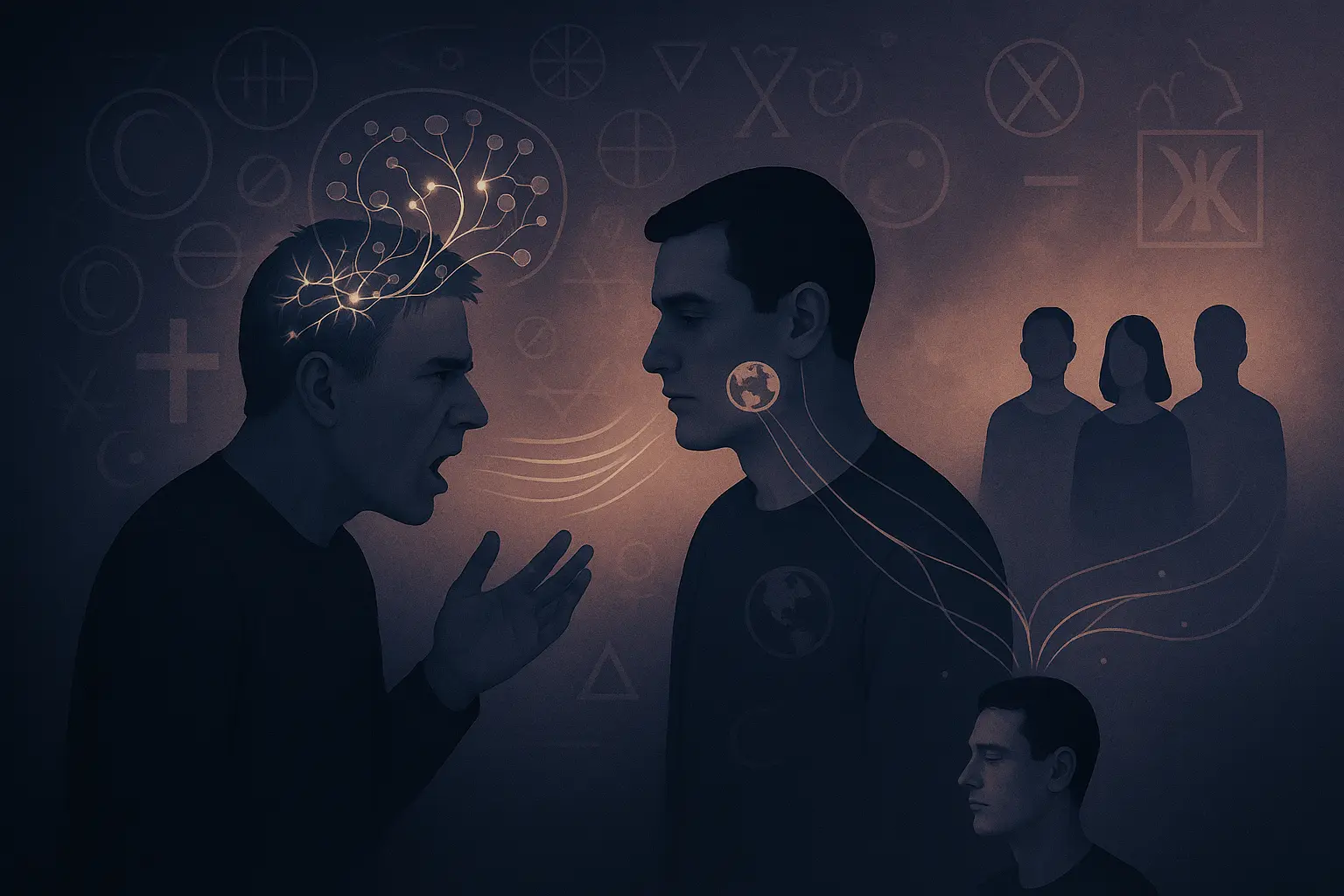Clinical records show that psychosis can be transmissible. In cases documented since the 19th century, rational individuals in close relationships with a psychotic person have adopted their impossible beliefs. The evidence confirms this transmission occurs, but the mechanism remains unexplained, recovery patterns contradict theoretical predictions, and modern psychiatric manuals cannot agree on whether this constitutes a distinct disorder.
When Logic Shifts Sideways
In 1877, French psychiatrists Charles Lasègue and Jean-Pierre Falret documented a phenomenon they termed Folie à Deux, or “madness for two”. They described cases where a delusional belief originating in one person was transmitted to a second, closely associated person. For over a century, this concept of “shared psychosis” was accepted in psychiatry, eventually being formalised in the DSM-III (Diagnostic and Statistical Manual of Mental Disorders, Third Edition) as Shared Paranoid Disorder.
Yet in 2013, the diagnosis was removed from the DSM-5 (the manual’s latest edition). It was not disproven; instead, it was reclassified under other psychotic disorders, such as “delusional symptoms in a partner of an individual with delusional disorder”. This decision was made despite a steady stream of clinical case reports confirming the phenomenon continues to occur.
This creates a central contradiction. How can a recognised disorder, documented for more than 140 years, be simultaneously real enough to observe in clinical practice but not distinct enough to warrant its own classification? The answer reveals fundamental questions about how belief, influence, and reality itself are negotiated between people.
Most understanding comes from individual case reports rather than large-scale studies, creating significant gaps in knowledge about its true prevalence. Medical literature contains over 300 documented cases spanning 150 years, all showing that rational individuals can develop the same delusional beliefs as someone close to them who is experiencing psychosis.
Mapping Transmission Routes

No single theory fully explains how a delusion crosses from one mind to another. Instead, several models offer partial insights, each with limitations.
Social and Psychological Models suggest that the secondary person learns the delusional beliefs through intense, prolonged exposure to the primary individual. Within a socially isolated environment, the primary’s worldview becomes the dominant, and sometimes only, reality available. The secondary, often in a dependent or submissive role, may adopt the beliefs to maintain the relationship, reduce conflict, or out of genuine inability to test them against external information.
Neurobiological Models propose an underlying biological or genetic vulnerability. A significant number of cases occur between blood relatives, suggesting a shared genetic predisposition to psychosis. Some researchers speculate that brain systems related to empathy and social understanding, such as mirror neurons (brain cells that fire when observing others’ actions), could play a role, though direct evidence remains lacking.
Cultural Models argue that the delusion’s content must be compatible with the secondary’s existing cultural framework. A belief rooted in shared religious scripture or local folklore may be more easily adopted because it is not entirely alien to the secondary’s worldview.
Each model breaks down at certain points. Social learning does not fully explain why some highly intelligent individuals succumb. Neurobiological models struggle to account for cases between genetically unrelated partners. All conventional models are challenged by reports where the secondary person appears to develop symptoms before the primary, directly contradicting established transmission pathways.
Alexander Gralnick’s 1942 review identified four distinct subtypes, each showing different transmission patterns:
- Imposed psychosis: delusions disappear upon separation
- Communicated psychosis: delusions persist after separation
- Simultaneous psychosis: both develop similar conditions concurrently
- Induced psychosis: an already psychotic individual adopts additional delusions from another
Who Catches the Delusion?
The historical image of the secondary as a “blank-slate victim” is not supported by evidence. Instead, data suggests selective vulnerability. A 2006 review by Arnone et al. found that 55% of secondary individuals had documented psychiatric history prior to the shared delusion developing. This suggests the primary’s psychosis may act as a catalyst on pre-existing vulnerability rather than creating pathology from nothing.
But, this does not mean all secondaries have prior diagnoses. Cases involving high-functioning academics, professionals, and otherwise healthy individuals demonstrate that specific relational and environmental factors can override typical psychological defences. These cases mirror patterns we see in the connectivity trap, where heightened cognitive processing can make people more susceptible to experiences others might dismiss.
Key Risk Factors:
- Social Isolation: The dyad or group is cut off from outside perspectives that could challenge the delusion
- Relationship Dynamic: The secondary is often in a dependent relationship with a dominant primary
- Shared Genetics: A high proportion of cases involve siblings or parents and children, suggesting shared genetic risk
- Prior Psychiatric History: The secondary often has pre-existing vulnerability, such as depression, anxiety, or dependency traits
- Cognitive Similarities: Shared levels of intelligence and education have been noted in some cases
These risk factors do not explain the selectivity of the phenomenon.
Countless individuals live in close proximity to psychotic family members without developing shared delusions. Some highly educated professionals succumb, whilst others in identical circumstances maintain critical thinking.
The most intriguing cases involve individuals who should be resistant. Respected doctors have adopted impossible conspiracies, academics have developed elaborate shared fantasies, and professionals have abandoned logical thinking for supernatural explanations.
Case Files That Break the Rules
Several documented cases challenge standard theoretical models and highlight the phenomenon’s complexity:
The Elizabeth Smart Abduction: Wanda Barzee was diagnosed by multiple experts with Shared Psychotic Disorder in relation to the messianic delusions of her husband, Brian Mitchell. Even after arrest and separation, she retained elements of the belief system, contradicting simple influence models.
The Seven Sleepers Case: A married couple developed shared mystical delusions based on an Anatolian legend and Koranic interpretations. Their belief that they would sleep for years and awaken in paradise led to the wife’s death from starvation. The case illustrates how cultural and religious frameworks can structure shared delusional content.
The Sisters’ Paradox: Two sisters with systematic shared delusions were separated for treatment. The dominant sister became increasingly anxious and died from an overdose. The non-dominant sister initially improved but later relapsed, requiring hospitalisation. This challenges assumptions about separation being universally beneficial.
Contradiction Matrix:
- Secondaries sometimes show symptoms before primaries are identified
- Delusions can persist or worsen after separation
- Recovery patterns are unpredictable
- Some cases report mutual influence rather than unidirectional transmission
These variations suggest individual factors often outweigh simple separation-cure models, highlighting the complex interdependency that can develop between affected individuals.
Treatment and Ethical Minefields
Classical treatment approaches focused on immediate separation, based on the assumption that removing the source of influence would cure the secondary. This strategy works in some cases but fails in others, particularly where delusions persist independently.
Modern approaches recognise the complexity of shared psychotic states. Separation may benefit the secondary, but it can precipitate a crisis in the primary, as demonstrated by cases where the primary deteriorated rapidly when separated from their partner.
Treatment Approaches
Separation
- Pros: Rapid improvement is possible and it can break the cycle of influence.
- Cons: Carries a risk of distress, self-harm, relapse, and family disruption.
Joint therapy
- Pros: May address the relational roots of the problem and preserves family ties.
- Cons: There is limited research on its effectiveness and it is often refused by the individuals involved.
Medication
- Pros: Can be useful for treating persistent symptoms.
- Cons: It is less effective if the delusional beliefs are being socially reinforced.
Legal action
- Pros: Can protect individuals who are considered to be at risk.
- Cons: It is intrusive and may violate the autonomy of the individuals.
Social support
- Pros: Reduces the isolation that often fuels the condition and aids long-term recovery.
- Cons: Can be difficult to sustain and is not a substitute for clinical care.
Pharmacological treatments show mixed results. Antipsychotic medications may help the primary’s core psychosis, but do not necessarily resolve the shared delusional system. Some secondaries require independent treatment even after separation, suggesting their condition has evolved beyond simple influence.
Ethical dilemmas arise around consent and insight. If individuals lack awareness of their condition, who can consent to treatment on their behalf? When separation might benefit one person but harm another, how should clinicians balance competing interests? These questions remain largely unresolved in psychiatric ethics.
Open Questions and Research Agenda
Despite 150 years of documentation, fundamental questions about shared psychosis remain unanswered:
Mechanism Questions: How exactly do beliefs transfer between minds? Current theories invoke social learning, emotional contagion, and neurobiological vulnerability, but precise mechanisms remain unclear. Why do some relationships foster belief transmission whilst others maintain individual perspectives?
Susceptibility Questions: What determines who develops shared delusions when exposed to psychotic thinking? Risk factors are identified, but they do not reliably predict individual outcomes. The role of genetic predisposition versus psychological vulnerability requires clarification.
Content Questions: Why do certain types of delusions spread more easily than others? Persecutory and religious themes appear more “contagious” than other forms, but reasons remain unexplored. How does cultural background influence which beliefs can take hold?
Recovery Questions: What Factors Determine Treatment Outcomes? The classical separation-cure model fails in many cases, but alternative approaches lack systematic evaluation. Long-term prognosis data remain sparse due to inadequate follow-up studies.
Diagnostic Questions: Should shared psychotic states be classified as distinct disorders or symptoms of underlying conditions? The DSM-5 reclassification reflects ongoing uncertainty about nosological status.
Future research requires innovative methodologies to overcome ethical and practical constraints. Multi-site collaborative studies could aggregate rare cases for systematic analysis. Neuroimaging research might identify biological markers of susceptibility. Cross-cultural studies could clarify the role of belief systems in shaping shared delusions.
The removal of Shared Psychotic Disorder from DSM-5 may inadvertently reduce clinical recognition and research interest, despite continued case reports. Establishing standardised assessment tools and international research consortia could maintain momentum in understanding this perplexing phenomenon.
The Persistence of Shared Certainty

Shared psychosis reveals something unsettling about the nature of belief and rationality. The documented cases demonstrate that even educated and intelligent individuals can adopt extreme convictions when subjected to the right combination of influence, isolation, and vulnerability. The mechanisms remain mysterious, but the phenomenon itself is undeniably real.
The evidence resists simple explanations. Belief transmission is not merely passive absorption but involves complex interactions between individual psychology, relationship dynamics, and social environment. Recovery patterns vary unpredictably, and treatment approaches succeed or fail for reasons that are not yet fully understood.
Perhaps most troubling is what these cases reveal about the fragility of rational thought. The boundaries between self and other, as well as between individual belief and shared reality, prove more permeable than commonly assumed. This raises profound questions about consciousness itself, particularly when we consider how ideas can literally inhabit and reshape minds – a theme explored in Philip K. Dick’s simulation revelation.
In an era of increasing social polarisation and digital echo chambers, understanding how rational minds can share irrational certainty becomes more relevant than ever. The MK-Ultra experiments demonstrated how psychological influence could be weaponised; shared psychosis shows us how it can spread organically through ordinary human relationships.
The contagion of certainty documented in shared psychosis cases offers a stark reminder: human beings are fundamentally social creatures, and our grasp on reality depends more on the company we keep than we care to admit. The question is not whether beliefs can spread between minds, but why it does not happen more often.
Sources
Sources include: peer‑reviewed case reviews by Silveira & Seeman (1995) and Arnone et al. (2006); DSM‑III to DSM‑5 diagnostic manuals; original case reports by Lasègue & Falret (1877) and Tuke (1887); court transcripts from USA v Mitchell & Barzee (2004); Tsarkov et al. field report on the Zambian prophetess case (2020); NHS statistical bulletins on shared psychotic disorder admissions (1990–2024); WHO ICD‑10 classification (1992) and ICD‑11 draft notes (2022); longitudinal family study in Psychiatry Research (2022).

Comments (0)